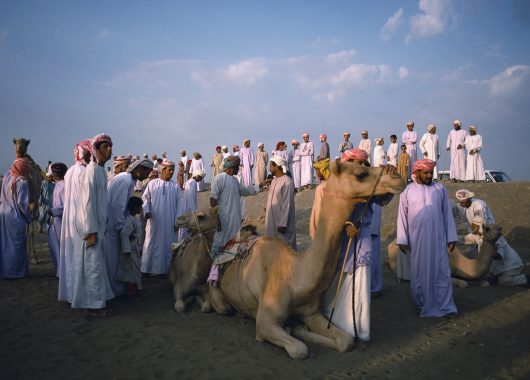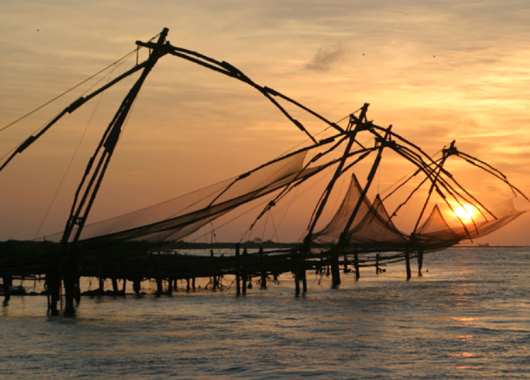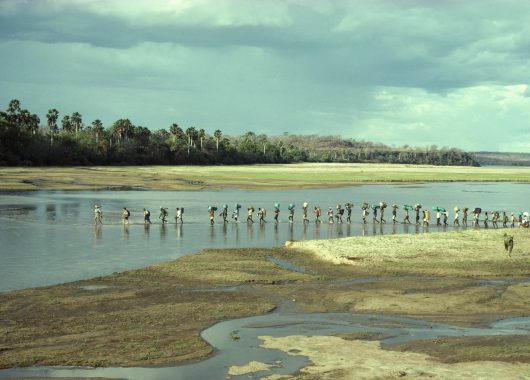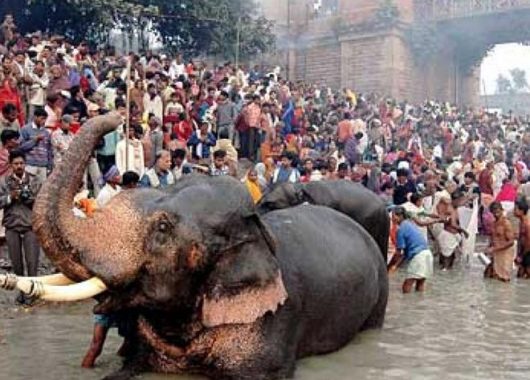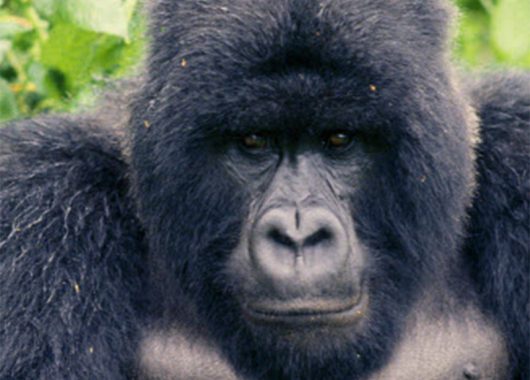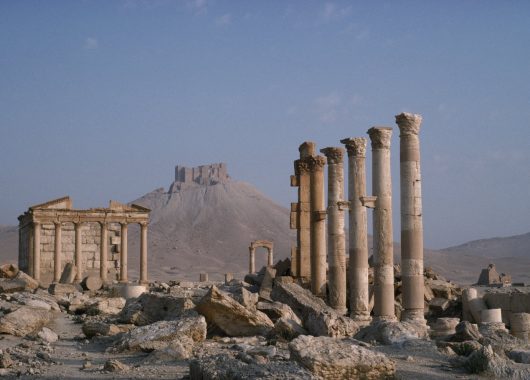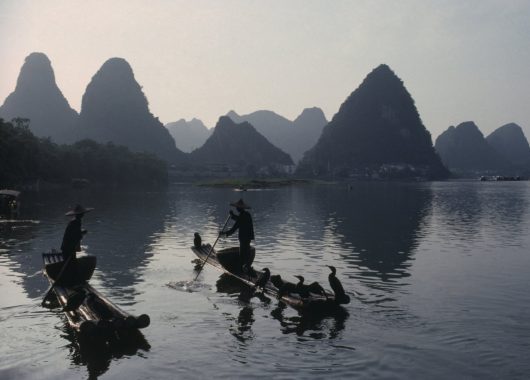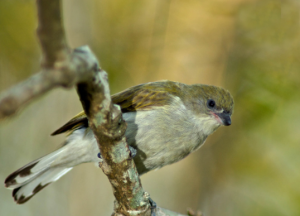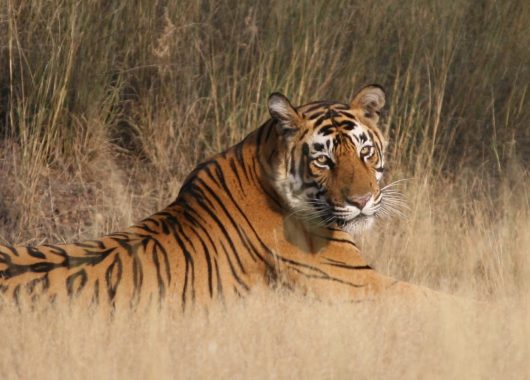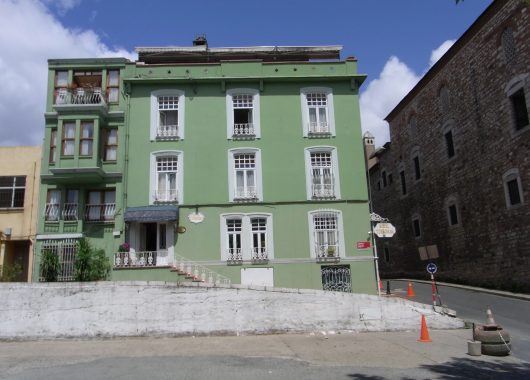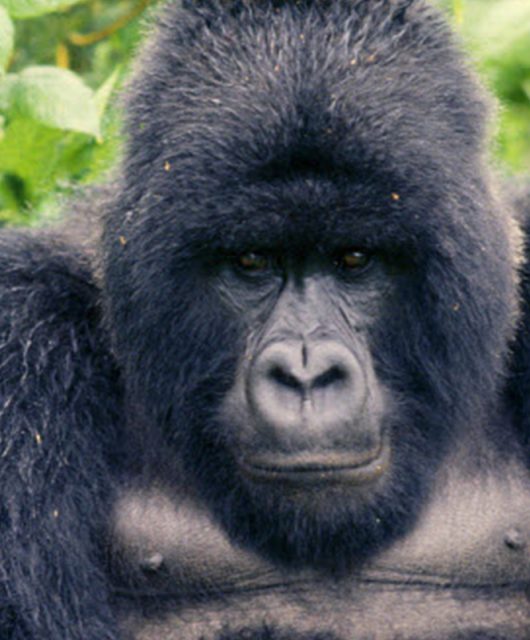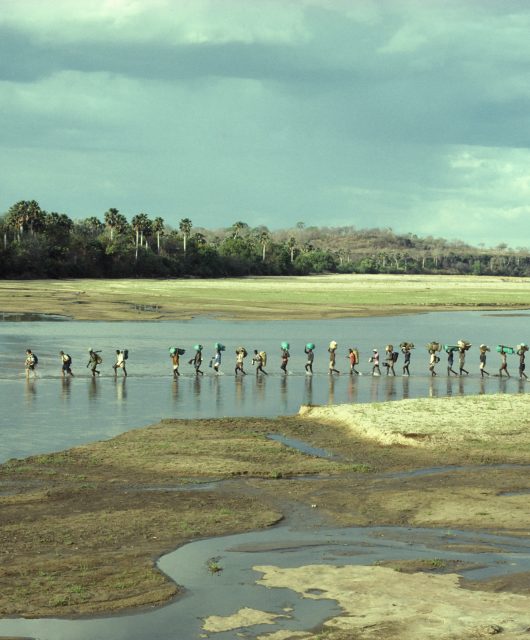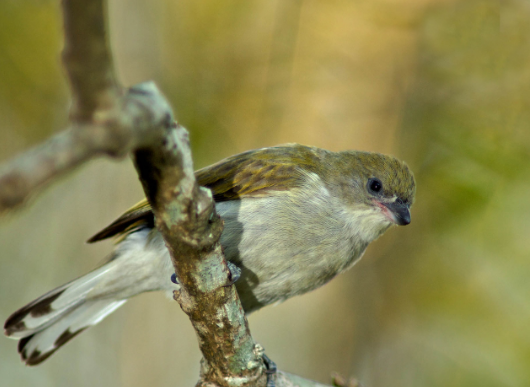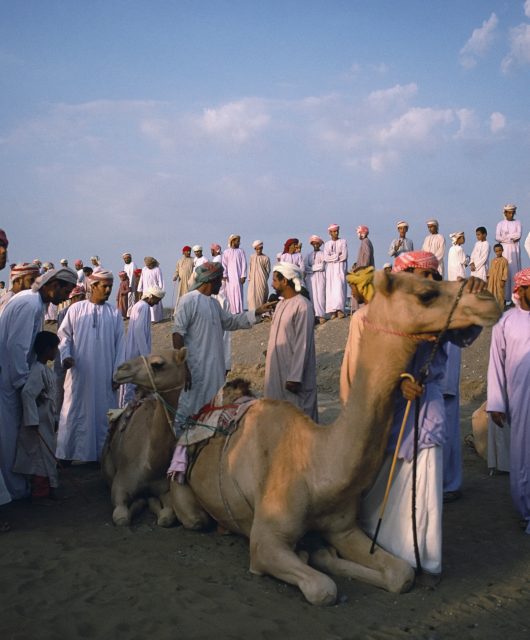Namibia
This article was first published by Harpers & Queen in October 1995.
A quarter of the world’s remaining cheetahs live in Namibia. It is a crucial population, for throughout the rest of the world their numbers have been fast diminishing. In 1900 there were more than 100,000 in Africa and Asia, now there are hardly 10,000. A tiny population remains in Iran, but the Indian cheetah became extinct in the 1960s.
At the end of March I flew to Namibia, the vast and under-populated country which was known as South West Africa until its independence from South Africa in 1990. My first destination was Okonjima, a guest-farm, which is also the base for one of the two charities trying to protect the last big population of this endangered cat. Okonjima, 15 miles down a dirt road through thorny savannah, used to be a cattle ranch, but is now gradually being returned by Wayne and Lise Hanssen into a natural habitat. The recently opened lodge has ten rooms set around a lawn and luscious flowerbeds. The unusual ingredient of this mini-paradise is a collection of semi-domesticated wild animals. After unpacking my case, I walked over to the small swimming pool, where I found a warthog drinking; as I approached, it rolled over on its back, apparently inviting me to scratch its stomach. A tentative tickling of its belly induced a thunderous purr; but the warthog isn’t just a pet, for it regularly disappears into the bush for days at a time. Other semi-domesticated animals came and went from the lodge. During one lunch an African Wild Cat rushed through the dining room, and after scrambling up the wall, peered down at us from the rafters; one afternoon an exquisite honey-coloured lynx with tall erect ears made a brief but nervous visit.
The star animal attractions are two cheetahs which are brought to the lawn at tea-time. They lick at bowls of cream, allow themselves to be stroked by hesitant tourists, and scowl at the various dogs that dare to venture too close. The Hanssens would have preferred to release these animals into the wild, but they had been trapped too young. A cheetah cub learns to hunt from its mother, who trains it for months, bringing back young gazelles for hunting practice.
After dinner Lise took me to the cheetahs’ large enclosure. As we arrived, a multitude of jackals started howling from every direction. She called into the dark, and after a few moments three cheetahs emerged, purring loudly as they rubbed against her. This purring – and the occasional mewing – would have surprised the many Africa-hands who are keen to assure one that the cheetah is really a dog. In fact cheetahs do differ markedly from other large cats: their claws are not fully retractable, they hunt by day, and their skeletons – built for speed – are similar to those of a greyhound. All the same, cheetahs do belong to the cat family, and I was amused to see that Lise’s cheetahs could be a touch contrary, just like so many domestic cats. When I knelt to take a photograph of her playing with them, they promptly decided that they would rather rest their necks on my own shoulder. When they grew bored with us, instead of hanging around like dogs, they raced off into the night.
Namibia is one of the wildest and most under-populated countries in the world. Nevertheless, apart from its famous National Park, Etosha, the visitor can’t count on seeing immense herds of game. As a result Namibia is sensibly developing its own style of tourism: there are no large hotels outside the capital – only small lodges, camps, and guest-farms, whose diversions often have a didactic flavour. In the mornings at Okonjima there is a menu of three guided walks; two of them – the Bushman and the Bantu – are led by Wayne Hanssen’s sisters, and are often accompanied by one of the lodge’s semi-tame animals. During my first walk one of the warthogs made a pest of itself, trying to get attention by rubbing against our legs, or squabbling with the terrier. Once the warthog had been shooed away, we were taught about aspects of traditional life in the bush: how nests of the Whitebrowed Sparrow-weaver can indicate the points of a compass, how to construct a porcupine trap, and how to make string – at an astonishing speed – from the leaves of the sansevieria plant.
Because of the comparative absence of big game, the Namibian guides are not only didactic, they concentrate more on detail, some of which is riveting once one has been taught to be observant. In Kenya I must have seen thousands of `ant hills’ but it was only in Namibia that I learnt the extraordinary facts about them. First, they are not `ant hills’ at all, but are built by termites, a totally unrelated insect; and the `hill’ isn’t a self-sufficient structure, but merely the air-conditioning apparatus of an enormous underground city inhabited by as many as two million termites. These are all organised into different groups of workers, some, for instance, looking after the cooling systems, some acting as soldiers, and a large number gathering dead vegetable material, which they swallow and then regurgitate in huge fungus-growing gardens, on which they feed the young and their queen. Like any sensible society they honour and succour their monarch; she grows enormous, as big as four inches, and rewards them by laying 36,000 eggs a day for year after year.
My final guided walk at Okonjima was the `Bushman Walk’ led by Wayne, in which he explained some of the skills he was taught as a youth. His father had told me that Wayne was as `happy as a hog in shit’ during his childhood, because instead of being sent down to boarding school in South Africa, like the rest of his family, he was sent to the local school. This enabled him to learn tracking from Bushmen at the weekends. Wayne’s talk was the best of its type that I’ve known: he showed us how a Bushman can tell if the antelope that he is tracking is pregnant, or if it is fat, or even if the antelope knows it is being followed. He also showed us how a Bushman works out the length of time an antelope has rested under a tree (this is obvious once it has been explained), and how a tracker can work out precisely how close he is to the prey, by using clues such as the paths made by ants. Every time he showed us one of the larger insects, it was grabbed by his ecologically-incorrect pet baboon, which munched it like a cocktail sausage.
Bushmen are the maestros of tracking, but not many of them are accustomed to areas of rocky ground where few signs are left on the hard surface. A friend in rhinoceros conservation told me that, although his organisation had used several Bushmen, their most brilliant tracker of all was a celebrated and aged Herero villager. In his early childhood he had had to search for lost goats in rocky areas, and thus learnt to recognise the smallest pattern of disturbance; later in his life he had picked up skills as a rhinoceros poacher. But when clues are sparse, as they can be with rhino, the Herero sits down, pulls out his pipe, and thinks himself into the mind of the animal. Is it looking for somewhere to rest? Is it zigzagging in search of new grazing? Is it going straight to water? He has never yet failed to find his rhino.
After Okonjima I returned to the capital Windhoek, which still has a European and slightly Germanic character. Namibia has been independent from South Africa for only five years. The German colonial era was much longer ago, but though it lasted only from 1884 till 1915 (when the South African forces invaded), the influence is still strong. In Germany’s other African colonies, no settlers remain, and little trace of the fatherland survives. In Namibia, though, many of the farmers are German, and so are most of the tourists. In Windhoek, the many white shop assistants are most likely to greet you with the words `Guten Tag’. The only two statues in the city are of Germans. The streets near my hotel are still named after German composers: `Brahms Strasse, Schubert Strasse, Wagner Strasse’ and so on. The restaurants are liable to offer slabs of pork with sauerkraut, though occasionally they reach the more exotic shores of culinary inspiration, with recipes such as `Kebabs of zebra’ or `Medaillons of ostrich in mango cream with noodles’.
Any photograph of people on a Windhoek pavement would easily identify the city. There are the unmistakeable and spectacular Herero ladies with long Victorian frocks, spread over layers of petticoats; on their heads they wear curiously constructed turbans with stiff flaps sticking out of the sides. Another noticeable community are the Basters (the word originally meant `bastards’) whose ancestors were the progeny of early Cape settlers in the Cape and the Hottentot women they co-habited with. The Basters gradually formed a community who were proud of their origins, but eventually they moved out of South Africa up to their present enclave south of Windhoek. Being of mixed blood, their skin colour varies, but it tends to be much yellower than in most other coloured communities. The most noticeable white members of the Windhoek scene are the German and Afrikaner farmers, who tend to have bellies hanging over their belts, tight brief shorts, and long socks into which they tuck their combs.
The white farmers move with the confidence of colonials, for although Namibia is run by a black government, it is still in many ways a white man’s country. Nearly all the large farms – almost all of them sheep or cattle ranches – belong to German or Afrikaner farmers. Within five minutes of your first meeting, most Europeans in Namibia will tell you that, out of the total population of one and a half million, only 80,000 are tax payers, most of whom are white.
The colonial era has left an infrastructure that is far better than in most African countries: the tap water is drinkable; the empty roads are superb, even minor roads are signposted, and the major ones have frequent picnic sites, equipped with green and white dustbins. The downside of the colonial legacy is a deep divide between the races, for the Germans and Afrikaners have always been hard on the indigenous inhabitants. In 1904 the Hereros started a rebellion against the German government, having had enough of being flogged, raped, and enslaved. During the subsequent military campaign, General von Trotha conducted a dry-run for later genocide, driving them into the desert, blocking up the water-holes, and hunting down the starving and thirsty refugees like animals. He wanted to commit genocide, but although he failed in this ambition, he did succeed in killing more than 75% of the entire Herero population.
The gap between the races is closing only slowly. If you see a blonde farmer driving a pick-up truck, you would be surprised to see an African in the seat beside him; it his more likely that his workers might be squatting in the back. Outside a German farm I saw a large sign, painted with skull-and-crossbones saying “Trespassers will not be prosecuted, they will be shot”. On a 40,000-acre ranch, where the farmer might have an aeroplane and several expensive cars, his workers and their families are usually housed in tiny shacks, made of rusty scraps of corrugated iron. These barren hovels are boiling in summer and freezing in winter. When I asked why farmers didn’t provide better accommodation for their labourers I would receive one of three answers: “It’s no good giving the African a proper house. We’ve tried and they just ruin them”. “It’s a strange thing, John, but you know the African just won’t move his house to the shade of a tree, which would make it much cooler for him”. Or “It’s the fault of the government. There’s a tax deduction if you buy yourself a new tractor, but no tax advantage if you build a house for your workers”.
During the South African administration of Namibia, the government instituted apartheid and separate development. Surprisingly, the latter has left a valuable legacy – Damaraland and Kaokaland in the North West of Namibia, which were designated for communal farming land by the few Africans who live there, and are therefore preserved as two of the wildest and most beautiful territories in Africa. It is a landscape of mountains and desert, and the breathtaking grandeur of immense open spaces has never been successfully caught by photographs. The only people I saw in Kaokaland were the Himba, who still dress in skins, and cover their body with red ochre; their untouched way of life is also a product of the South African era, for no ordinary visitors were allowed in their area until the 1970s.
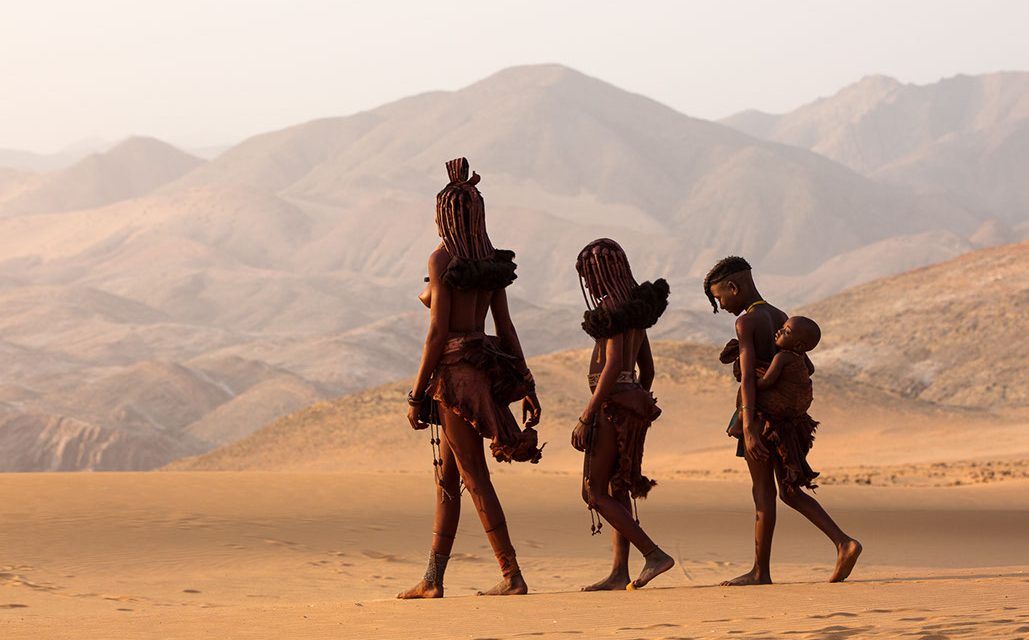
Emptiness has ensured that this region is the last area of Africa where there is a genuinely wild and free-roaming population of black rhinos. It is also the home of another remarkable rare animal, the desert elephant, of which about 80 still survive. This is not a separate species, but a variety that has adapted to the desert terrain. In their search for water they sometimes have to travel as much as 30 miles a day, and sometimes have to achieve a most un-elephantine feat: sliding down a sand-dune so that they can get at the only available water-hole. Elephants are usually notorious for their destructiveness, uprooting countless trees that never grow again; but here they daintily pluck at bushes and trees, as if aware that their usual destructiveness would cause them to starve on their next visit.
I was surprised to learn that elephants can still be hunted in Namibia, and on investigating further, discovered that there has been a remarkable boom in all types of hunting. Many farmers have realized that in this drought-ridden country it is far more profitable to get rid of cattle, and build a tall fence around their ranch – turning it into a game farm to lure rich clients from Germany and America. Some hunting businesses also own concessions in non-farming areas. Mount Etjo, a tourist lodge owned by a friend of the President, operates one of these concessions, and charges hunters a trophy fee of $8,000 an elephant. Their other trophy fees include $3,500 for a lion, $2,000 for a cheetah, $2,000 for a leopard, $1,000 for a giraffe. Small cats, jackals, and baboons are free-of-charge. The brochure of another lodge, Wabi, which is under Swiss management, assures clients that they will “enjoy being spoiled. Every bungalow is equipped with a bath, shower, bidet, WC and 220 volt plugs: everything you need to make life comfortable for yourself – and that special person with you”. Their trophy fees include $2,000 for a leopard, $1,500 for a giraffe, $1,000 for a cheetah, $400 for an ostrich, $75 for an African wild cat, and $75 for a baboon. There are now so many hunting lodges that the Namibian government is able to hold auctions at which they sell off live animals from their national parks.
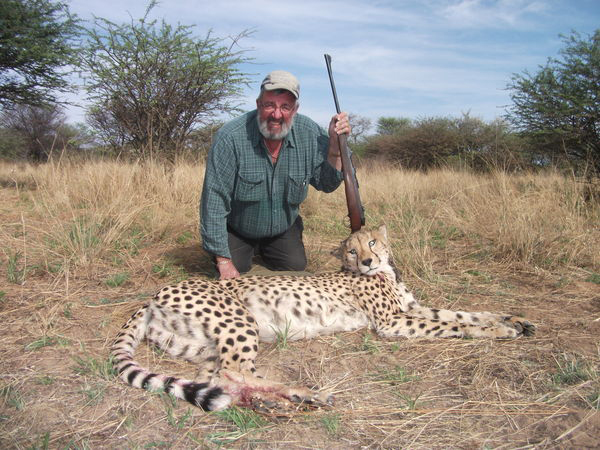
Most Namibians are delighted by the boom in hunting. They claim it is all very `green’, pointing out that if you put an economic value on an animal, someone will have an interest in preserving it. Some of this `greenery’, though, has a whiff of astro-turf. Hunting certainly can play an important part in protecting habitat and animals – a good example may be the buffer zones between farms and National Parks. And wild game may sometimes be more efficient – and less destructive – than cattle for producing protein from an arid region. But, until the system is better regulated, the growth of hunting farms in Namibia isn’t wholly beneficial. Many of the hunting lodges import exotic species because clients will often pay high fees to shoot them. These alien animals are not only degrading the natural environment but, because farmers are legally obliged to build tall fences to retain them, many minor and major migration patterns are disrupted. And sometimes, despite leopard and cheetah having a trophy value, the farmers find it economic to eradicate them so as to preserve their expensive stock of imported exotic antelope.
Throughout Southern Africa there are now increasing complaints about the ethics of certain hunting companies, whether in private game reserves or in public concession areas. It is well known that many of their clients are too old, infirm, or lazy to hunt on foot, and that they therefore fire from vehicles – a particularly easy option because many wild animals remain much less frightened of a vehicle than of a walking human being. And there are rumours that some of the trophies are not properly wild. Many of the stories about the use of retired circus lions can possibly be discounted, but the provenance of some of the trophy cheetahs is questionable. Unlike leopards, cheetahs can’t be lured to bait; nor can they be relied upon to stay in the same area, for their territory can be twice the size of Middlesex, and they are constantly on the move. Therefore, as no professional hunter can guarantee his client a cheetah, it is believed that a few unscrupulous hunters release animals that have recently been trapped and possibly even drugged.
All the same, though some modern trophy-hunting may be unappealing, it certainly is not the main reason why Namibia’s cheetah population has halved since the 1970. The main problem is that most Namibian cheetahs don’t live in National Parks but in farmland, usually on ranches owned by white farmers. In National Parks and Game Reserves cheetahs are harassed by rival predators, especially lions and hyenas, who drive them off their kills and murder their cubs. Nevertheless the ranches don’t offer ideal security, for Namibian farmers treat cheetahs as vermin: during the last decade they have trapped more than 7000, most of which they killed.
The Cheetah Conservation fund, run by a charismatic American couple, Daniel and Laurie Kraus, are trying to reduce the scale of this destruction, studying every aspect of the problem, both academic and practical. When I went to stay with them, my first question was how could the farmers find it so easy to trap an animal that is known for being solitary, wide-ranging, and un-baitable. They explained that many Namibian cheetahs have a compulsion to visit `play’ trees. This is a specifically Namibian behaviour, unknown in other cheetah societies. The chosen trees are usually ancient ones on which cheetahs exhibit play-like behaviour and leave their scent-marks. Although the Cheetah Conservation Fund now has a young German who is studying play-trees, not much is yet known about them; but it is believed that they act as a type of notice-board. For whatever reason, the cheetahs have such a formidable compulsion to visit the trees that they are easily caught by farmers placing box-traps at the site. One farmer, who has four play-trees on his ranch, has killed more than 200 cheetahs during the last thirteen years.
Daniel and Laurie Kraus are gradually trying to visit every relevant Namibian farm to persuade the farmers to be more cheetah-friendly. Because at least 90% of Namibia’s cheetahs live on farmland, their survival in the wild is essentially in the hands of only a thousand farmers. And therefore, like Africat (the Okonjima-based cheetah charity), Daniel and Luarie give talks to groups of farmers, who are sometimes a tough audience. The first slide of cheetahs is likely to be greeted with a chorus of boos; the observation that the cheetah is the fastest land-animal is likely to be met with the shout “But not faster than a bullet from my 270”. Yet the farmers are getting more sophisticated, and are often warm-hearted if contacted personally. Instead of always killing a trapped cheetah, some of them now telephone one of the two charities, offering them the live animal.
This is probably better than execution, but there are no ideal options for a trapped cheetah. Most National Parks, with their population of lion and hyena, are unsuitable, and other regions which should be suitable are already likely to have their quote of cheetah, who will be very aggressive to a newcomer. The alternative, captivity, is obviously unsatisfactory, for even some of the kindest owners have to keep them in an area that is unnaturally confined.
We no longer consider it right to keep a wild animal captive for our pleasure, but in the past cheetahs have been popular as pets, especially as they don’t turn on their owners, an unfortunate habit of the other great cats. Their compatibility with man has also made them popular for coursing gazelles, especially in the Middle East and Asia. Before the time of Christ they were used for hunting by the Assyrian dynasty; by the 13th Century they were being kept in India, and our word `cheetah’ derives from the Sanskrit word for `spotted’. The mogul emperor Akbar owned more than a thousand cheetahs, and even until the middle of the last century, Indian princes still used them for hunting.
One alone of Akbar’s many cheetahs ever gave birth, and after this there was a gap of more than four hundred years until the next captive birth in 1956 in Philadelphia Zoo. Although cheetahs survive captivity, they breed well only in the wild. Zoos have recently learnt to be more breeders, but not sufficiently for the zoo population to be self-sufficient: there are more deaths than births.
The best way of protecting the world’s remaining cheetah population, is not captivity, or relocation, but to persuade the farmers that they can live alongside them. Daniel and Laurie try to spread the message that the killing of a predator often merely creates a vacancy for another one, and that it is often more effective to concentrate on protecting stock at crucial times: for instance, cheetahs don’t kill adult cattle, so extra care should be taken of calves when young and vulnerable.
The Cheetah Conservation Fund is also studying and developing two remarkable projects, one for use with sheep, the other with cattle. The first, based on research done at Hampshire College, Massachusetts, uses guard-dogs that bond with their flock rather than with a shepherd. Following the college’s advice, the Krauses have chosen Anatolian Shepherd dogs, which are put with the sheep at a very young age so that they bond with them, eventually guarding them day and night. There is still much to learn, but whenever dogs have stayed with the flocks, they have succeeded in deterring cheetahs, as well as other predators such as jackal and lynx.
A similar idea is being tried with cattle, but using a donkey instead of a dog. Laurie Kraus took me to an unpretentious Afrikaner-owned farm, a bungalow with a few trees and almost no garden. The young farmer led us straight out to the fields where he showed us a donkey placidly grazing among his cows. After he took us back for coffee in his kitchen, I expressed surprise that a mere donkey could keep away predators; but the farmer told me that, provided the donkey has a foal when she is bonded with the calving herd, she can be very aggressive. In 1985, before he used the donkey, he lost 32 calves to predators, but in all the years since then he has lost only one. He told me that some of his farming friends have been equally successful with trying donkeys along with better herd management, and there is hope the scheme might spread through the cattle ranches of Namibia.
On the grapevine I heard about an unusual Afrikaner farmer, who is passionately against hunting and who has an eccentric menagerie, including 10 lions and 11 cheetahs. Hoping to be able to go there as my last Namibian destination, I telephoned Mr Van de Merve, who told me that he was soon going to open his zoo to paying guests, and he kindly asked me to be his first visitor, even though he wasn’t quite ready.
With Salome, my guide, who used to be in the South African Army and still carries a pistol in her handbag, we drove 130 miles west of Windhoek in the direction of the Kalahari. The road led through flat savannah, populated by only a few lonely farms, marked by a pencil-like cypress growing above the thorn trees. After Gobabis, a farming town, we drove another 70 miles on dirt roads, and then along 5 miles of sandy private drive. On arrival my spirits sank a little, for I hadn’t envisaged quite so much of the messy fencing that is associated with zoos. However, I was soon cheered by the warm welcome of Nick Van de Merve, who explained that all the large animals in his private zoo had been saved from slaughter by farmers or hunters.
Taking us past a crocodile pool and a small garden embellished with a urinating cherub, he showed us into our courtyard-facing bedrooms, whose walls were hung with numerous bawdy jokes (Sample: Why is a beer better than a woman? When you go to a bar, you know you can always pick up a beer.) Next morning we crossed the courtyard to the family kitchen where we had a hospitable and tumultuous breakfast. Numerous people came and went including Mr van de Merve himself; his pony-tailed vivacious wife; a raging beauty of a daughter, who is fluent in the Bushman click-language; a son wearing a long dangling ear-ring; Max, a friendly young man who looks after the animals; and two tiny scurrying Bushmen maids, whose shy flat faces never looked directly at me. The only sedate presence was an elderly lady in a flower-pattern dressing gown, sipping a cup of coffee. I enquired if she was the grandmother, and was told “No, she’s an aunt; we all fight to have her to stay”.
Cats scampered about the floor, occasionally scrapping with dogs. I felt a clawing at my legs, and without looking carefully lifted a cat onto my lap; I soon realised that it was a baby lion. Behind me a plastic fountain dribbled; at the other end of the room an African Grey Parrot screeched; Mr Van de Merve shouted periodic instructions into a transmitter; the loud television remained tuned to a programme of athletic games for the disabled.
After breakfast Max took Salome and me on a tour of the farm and the zoo. I asked why, in one of the large compounds, the workers always seemed to be pushing empty wheelbarrows. Max explained that the lions were nervous of wheelbarrows, and therefore wouldn’t pounce on these workers. Max himself often plays with lions. In reply to my nervous queries he said that it wasn’t too dangerous if you always respect them, watching their expressions carefully, and not playing with them in the full heat of the day or at mealtimes. After this explanation, he entered one of the compounds and started what seemed to me to be an alarming rough-and-tumble with one of the lions. The enormous cat often grasped his arm with its teeth, and once, when it held him tight, Max grimaced in pain and gave the lion a slightly-more-than-playful pummelling.
Because my departure from Namibia was so near, I wanted to ensure that I had some good close-up photographs of cheetahs, and therefore on my last evening Mr Van de Merve took me to the ten-acre enclosure where he keeps them. I had no intention of going inside, for though tame cheetahs are said never to make unprovoked attacks, these were wild animals that had been live-trapped by farmers. However, Mr van de Merve assured me that even wild cheetahs would be quite safe, so I went inside, took a few photographs, and then tried stalking some jackals, who had emerged as the sun was going down. While I was concentrating on getting close to them, a cheetah charged in my direction, coming to a halt only a few feet away. It then snarled. I realised that there was no point in running away, for the cheetah is the fastest land animal in the world. (Speeds of nearly 70 mph have been recorded, and for about three seconds its acceleration can be faster than that of a Ferrari.) So, nervously hoping that Mr van de Merve’s comforting words were true, I crouched to take a photograph. The cheetah lived up to the innocent reputation of its species, staying long enough for another three pictures, before slinking off with only an indignant glance over its shoulder.
![]()
NOTES
I have deleted most of my Notes for the article, as they are so outdated. But I have left the following two, just in case they are of use.
WEATHER.
Namibia can be visited for most of the year, but if you are planning adventurous trips off metal roads, be wary of the rainy season, when many roads are washed away. Generally Namibian weather is good, for it is never cold during the day (except for a few days in July), and yet it is nearly always cool enough to sleep at night. If you want to visit the famous sand dunes at Sossusvlei, don’t go during the hottest months, when you would boil. If you are interested mostly in animals, remember that in Etosha the game is very dispersed during the rainy season and when the grass is still green. Etosha starts getting good in June.
Namibia has different climatic zones, but here is an approximate guide. From the end of December until mid-March is the rainiest season, especially in the north. On the whole too rainy and hot for camping. April is a nice month: green, still warm. May is a good month: nice nights, no rain, very good for walking. June: green grass is starting to turn yellow. A jersey for mornings and evenings. July and August are much the same as June. September: weather is getting warmer again. Dry. Good for Etosha. Might need jersey morning and evening. October: warmer and dryer than September. Most greenery has disappeared. November: same as October. Hot and dry. December: very hot and dry. Little rain until the end of the month. Nights cool.
AN ADDITIONAL COMMENT
Namibia is a huge country, five times the size of England, and it is best not to try to cover it all on your first trip. Many first-time visitors want to go to the famous sand dunes at Sossusvlei, but bear in mind that this implies a dog-leg journey, probably using two days. And, if you do go there, you won’t relish its full beauty unless you take your time.
If you have never been to Africa, and your main desire is to see large herds of game, your first trip should probably be to East Africa. Once you have got this out of your system, Namibia is a superb destination with an atmosphere and landscape quite unlike anything else in Africa.
ADDENDUM (2017)
Since writing this article, I have come across a most interesting book about cheetahs in India. The End of the Trail by Divyabhanusinh (Oxford University Press, Third Edition, 2006). From this I learnt there are still people alive in India whose fathers trained cheetahs for Indian royalty to hunt. They mostly hunted blackbuck.
Cheetahs became extinct in India in the 1950s. Remarkably, a small endangered population still survives in Iran. When researching the subject, I found to my surprise that, within my own lifetime, both lions and tigers also survived in Iran. They are now extinct: only the few cheetahs survive.
![]()
Articles by John Hatt
Other Articles
![]()
![]()

